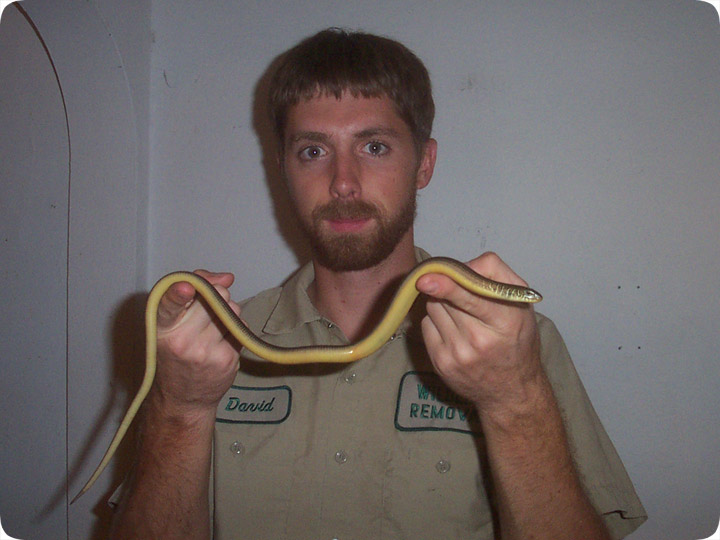-
info@aaanimalcontrol.com
Call us for help in your town
Humane Wildlife Education
Legless Lizard

08.12.2004 - This is an Legless Lizard, often referred to as a Glass Snake, although the true name of this reptile is the Eastern Glass Lizard. What's that you say? I'm wrong you say? You know a snake when you see one, your granddaddy taught you what is and what
is not a snake and he'd say that this is a snake, you say?
Well you, and your granddaddy, are wrong. It's a lizard. It just so happens to have the same body design as a snake. This is similar to the way a dolphin may be a mammal, but looks more like a fish, because having
smooth skin, a torpedo shaped body, flippers and fins is a great way to thrive in the water. Oftentimes, completely different species of animals take on the same characteristics as each other.
This phenomenon is known as convergent evolution. Oftentimes, a certain body type or other characteristic is more advantageous to survival, and thus wins out over time. Snakes have a great design which allows easy movement through tight spots and the
ability to sneak up on prey in a smooth fashion, and so some lizards branched off and adopted a more
snakelike shape and movement, and smaller limbs were a greater asset, and eventually the limbs disappeared completely. Glass Lizards have some tiny remnants, just as whales have tiny hind leg bones hidden beneath all that blubber, but overall, Glass Lizards look like snakes.
But look more closely, and you will see two very distinct and important differences. First, this reptile has eyelids, as all lizards do, but no snakes do. Second, it has earholes, a trait of lizards, but snakes have no ears. And if you actually hold and handle this
animal, it feels distinctly different from a snake. A snake feels more elastic, like a long muscle with ribs, and it's flexible with a flat belly. The Glass Lizard feels more stiff and wiry and springy, with a very round, almost hard, body. It's more likely to
flop around in your hands than to coil itself around your hand and squeeze like a snake. So yes, it's a lizard, one without legs, so people decided to call it a legless lizard. Myself, I'd rather call it an Eyelidded Snake.
Do it yourself: Visit my How To Get Rid of Snakes page for tips and advice.
Get professional help: Visit my Nationwide Pro Directory of wildlife removal experts.
For more wildlife stories, click my Wildlife Blog
or click my below banner to hire a local trapper.
If you've seen them before, they look like snakes to the unsuspecting eyes. However, they possess external ear openings, eyelids, extremely long tails and they lack broad body scales - unlike snakes.
Legless lizard is a collective term that defines lizard species that have lost their limbs or reduced it to a point it's unused in locomotion through the process of evolution. In the United States, one common group of legless lizards is the glass lizard. Some common species include the Eastern glass lizard, Mimic glass lizard, Island glass lizard, Slender glass lizard, and California legless lizard.
This post will explore all you need to know about glass lizards.
Appearance
Glass lizards are usually green, tan, brown, and yellowish colored and are covered with various dark markings on the lateral and dorsal sides.
They can grow up to 120 cm long, of which two-third of this length is just the tail. Glass lizards got their name from their ability to divide their tail into several pieces (like broken glass). This special adaptation is critical for their survival. Once in the face of danger, it dislodges its tail. The moving tail distracts the predator while the lizard lies motionless, before eventually escaping. Re-growing this tail requires lots of effort and energy and in many cases, it does not grow up to the original length. Due to the fragility of their tails, it is extremely difficult to find a glass lizard with a full tail.
Habitat
Glass lizard belongs to the family Anguidae. With 15 species, they primarily occupy Asia, North America, and North Africa. In North America, they are almost everywhere. However, several species inhabit the south-eastern United States, like the barrier islands off the Atlantic coast of Florida, as well as in Eastern North Carolina.
Mating Behavior
Depending on the specie, some give birth to their young alive, however, most lay eggs. Mating takes place in early summer, after which a female glass lizard can lay anywhere from 7 to 16 eggs, usually under the dense layers of leaves in the forest. She then protects the nest and tends to the eggs to avoid the growth of fungi. After an incubation of 50 to 60 days, the eggs hatch. They reach sexual maturity in about 2 to 3 years.
Feeding Behavior
Glass lizards are carnivorous predators and they feed primarily on insects. Just like other lizard species, they spend the day recharging under the sun. This stored up energy is activated at night as they become nocturnal hunters under the cover of the dark. Asides from insects, they can also feed on eggs, small birds, and rodents, as well as frogs. However, since they do not have flexible jaws like snakes, they cannot swallow animals larger than their heads.
Predators
Based on where they are residing, several other species have specialized in hunting glass lizards. Some examples include snakes, birds of prey, and mammals like foxes, skunks, and raccoons.
Life Span
In the wild, glass lizards can live anywhere from 10 to 30 years.




















